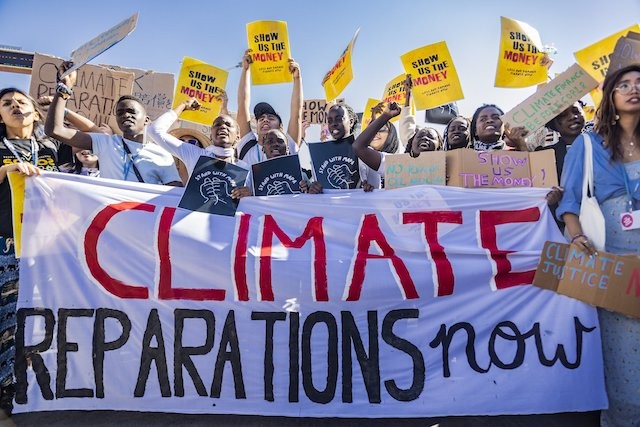After COP29, Ten Ways to Get Involved for Global Climate Justice
By
Hanna Homestead
Posted:
|
Climate Change,
Military & Security

Photo courtesy of Transform Network
The COP29 climate summit concluded over the weekend with a new, much-anticipated global target for international climate finance. Rich nations agreed to collectively provide at least $300 billion in climate finance to developing nations by 2035, an increase from the $100 billion annual goal set in 2009 (though far less than what the Global South wanted and actually needs).
Soon, all signatories of the Paris Agreement will be submitting updated national climate plans outlining their individual contributions to meeting the new collective goal, among other climate actions. The U.S. was already behind in paying a fair share towards climate finance, and now President-elect Trump is vowing to undo much of the progress that was made over the last four years under Biden. While these circumstances are daunting, continuing the fight for climate justice is more important than ever.
The Biden Administration supported efforts to increase the U.S. contribution to global climate action, stating investments in climate finance are "reasonable and necessary to protect and advance U.S. national and economic security.” Biden’s 2021 national climate plan pledged the U.S. would contribute $11 billion annually to international climate aid by 2024 through public (taxpayer) funding that mobilizes additional private-sector investment. Last week, he announced his Administration exceeded this historic goal. However, watchdog organizations warn that mobilized climate finance reports should be taken with a grain of salt, as they are likely overstated.
Actual public spending on international climate finance under Biden totals roughly $4 billion, to date. This includes Congressionally enacted FY 2022, FY 2023, and FY 2024 amounts and $1 billion that President Biden redirected to the Green Climate Fund. While Biden requested an average of $3.6 billion for international climate finance annually, Congress only approved an average of $1 billion - cutting the President’s requested topline amounts by more than two-thirds. Congress has yet to pass the FY2025 budget, where Biden’s international climate finance request is “not less than $3.3 billion” out of the $7.3 trillion with a “t” federal spending bill.
Though the Biden Administration oversaw historic increases in funding for international climate finance, U.S. climate aid fell far short of the $40 billion the U.S. should have paid annually toward the original $100 billion goal. Unfortunately, things may get worse before they get better. The climate budget was slashed during President-elect Trump’s first term, and the likelihood that he will work to fund a fair share of the new $300 billion finance target is bleak. Both the incoming Administration and Republican-dominated Congress are filled with climate deniers who will pose a host of new challenges to achieving the scale of policy change we need.
The deprioritization of climate finance is completely out of touch with the priorities of the American public. While the majority of Americans support combating climate change, nearly two-thirds of the federal budget is spent on militarism - dwarfing public investment in climate action. New analysis from NPP shows that over the last decade, the U.S. spent nearly 40 times more taxpayer dollars on Foreign Military Financing (grants to subsidize the sale of U.S.-made weapons) than spending on the Green Climate Fund, which provides finance for climate resilience in the world’s poorest nations.
These policy choices are ecologically devastating and undemocratic. Polling shows that 70% of Americans disapprove of selling weapons to foreign countries, while 75% say they support U.S. participation in international efforts to reduce the effects of climate change globally.
The disastrous effects of a warming planet are already being felt - including the increasing frequency and intensity of storms like Hurricane Helene - with the worst effects impacting communities least responsible for them. As the world’s largest global arms dealer, historical carbon emitter, and exporter of oil and gas, the United States has an obligation to fund climate action - not subsidize corporations profiting from endless war and climate catastrophe.
Despite all we face, frontline communities haven’t given up - and neither will we. The fight for a livable future is more important than ever, and solutions are possible. While the situation is dire, every tenth of a degree of warming makes a difference, so we can’t stop just because of a few setbacks. Efforts to secure a just energy transition, invest in the care economy, and reallocate public resources from the Pentagon and the world’s largest polluters to climate action are popular and achievable. Here are ten ways to get involved:
-
Visit the ShiftUS campaign website to learn more about climate finance and the Fair Share NDC campaign
-
Read or watch this webinar on why a progressive US-China policy is critical to addressing the climate crisis, and take action with Justice is Global
-
Sign this petition to make polluters pay for critical climate action
-
Learn about the destabilizing role oil plays in the Middle East and U.S. foreign policy
-
Learn how war and colonialism are drivers of debt and climate crisis
-
Learn about the non-violent direct action climate movement
-
Join and donate to solidarity and mutual aid initiatives
-
Find a local organization fighting for environmental justice in your neighborhood or state
-
Contact your representatives and tell them to fight for (and fund) a livable future
In the weeks, months, and years ahead, we must continue working to shift power and uproot the status quo. Most importantly, we must commit to following the leadership of frontline communities who are most impacted by the climate crisis and most knowledgeable about effective solutions. Though undoubtedly difficult, there is also joy to be found in collective struggle, rooted in generative action and care for our communities and planet. We all have a role to play - and all of our futures depend on it.